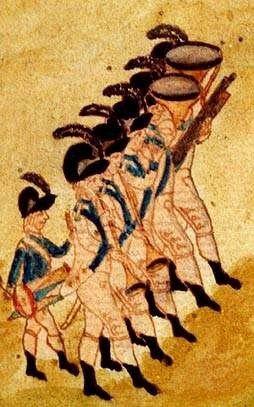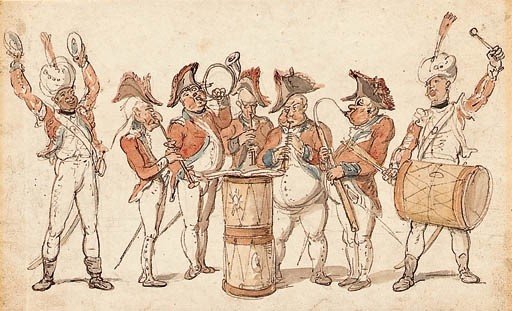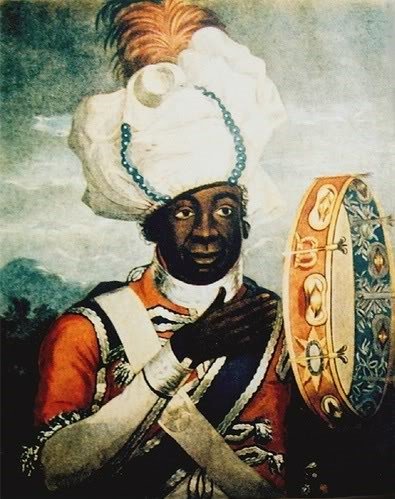Bands of Music in the British Army 1762-1790. Part 3
In the previous two postings, we've looked at what a band was, who were in them, what types of music a band played, and what kind of ceremonies they played at. Perhaps most interesting to those lovers of material culture and military uniforms is what these bandsmen wore.

The uniform of a bandsman varied depending on the regiment. These men were not drummers and fifers so the rule of reversed facings does not apply to them. Ultimately, the uniform of the band was left up to the officers paying for them. One way to see what they wore is through deserter ads. This first one comes from our very own 17th:
Deserted from his Majesty’s 17th regiment of foot, quartered in Perth, John Humphreys musician, aged twenty years, size five feet six inches one-half, very swarthy complexion and jet black hair, black eyes, hollow cheeks, has a stoop in his shoulders, slender bandy limbed, has a very hoarse voice, talks thick, plays well on the French horn and fife; had on when he deserted the musician’s uniform of the regiment, viz. a scarlet frock, with white cap [sic - cape] and cuffs laced with silver, with white buttons having the number of the regiment, white cloth waistcoat and breeches, silver laced hat. He was apprehended (but escaped) on Wednesday the 7th in the Canongate; had on a bonnet, black coat, and wore a long staff in his hand.[13]
It's important to note that the bandsman is not in reverse facings. These men were not drummers and fifers and were not held to the same rule that made them reverse colours. For most regiments, the bands simply kept the same colour coats as the enlisted and officers. The band of the 22nd Regiment did the same as the 17th. Their band wore red coats with the regiment's buff facings, buff waistcoats and breeches.[14]
Another deserter ad from the 21st Regiment or Royal North British Fusiliers describes:
JOHN GRANT, aged 23 years, 5 feet 2 3/4 inches high, born in Beverly, in Yorkshire, England, by trade a jockey, has brown hair, grey eyes, fair complexion, a little pitted with the smallpox, and very thin made; had on, when he deserted, his uniform blue jacket, turned up with a red cape, and cuffs. Whoever apprehends and secures the above deserter, shall, by giving proper notice to Captain NICHOLAS SUTHERLAND, Commanding Officer of the said regiment, at Philadelphia, receive ONE GUINEA reward, over and above what is allowed by Act of Parliament for apprehending deserters.
N.B. He is supposed to be gone to Maryland, as he has a wife and a plantation in that province.[15]
The most interesting fashion trend of the 18th century comes from the Turks. Janissary clothing and g became incredibly popular in bands of music. Cymbals and jingling johnnies, long poles with numerous bells, became common sights. In the image below attributed to Thomas Rowlandson, the drummer and the cymbal both wear turbans in the Janissary fashion.[16]

An even more striking example Janissary fashion is exhibited in the portrait of John
 Fraser, a percussionist in the Coldstream Guards. He wears a large turban with feathers sticking out of it. His red coat features silver lace and tassels. His sleeves are red in the upper arm but turns into a white fabric. His instrument, the tambourine, is a direct import from Janissary music. Bands of music were integral to the martial music of the British Army. Stemming from the Harmoniemusik movement of the 18th century, regiments adapted the instrumentation to fit their needs. The talented soldier/musicians of these bands played everything from military marches to operatic symphonies. To set them apart from soldiers and drummers, their uniforms reflected the tastes of their officers as well popular movements in late 18th century pop culture.
Fraser, a percussionist in the Coldstream Guards. He wears a large turban with feathers sticking out of it. His red coat features silver lace and tassels. His sleeves are red in the upper arm but turns into a white fabric. His instrument, the tambourine, is a direct import from Janissary music. Bands of music were integral to the martial music of the British Army. Stemming from the Harmoniemusik movement of the 18th century, regiments adapted the instrumentation to fit their needs. The talented soldier/musicians of these bands played everything from military marches to operatic symphonies. To set them apart from soldiers and drummers, their uniforms reflected the tastes of their officers as well popular movements in late 18th century pop culture.
When the 23rd Regiment was inspected on May 27, 1768, Major General Oughton said:
"The band of Musick very fine. The whole perfectly well cloathed and appointed."[17]
After John Rowe attended the concert of Fife Major McLean in Boston, he wrote in his diary that;
"there was a large genteel Company & the best Musick I have heard performed there."
These bands were designed to impress their officers and audiences from the songs and instruments they played down to the lace on their coats.[18]
Footnotes: [13] Edinburgh Advertiser, 9 October 1772. Courtesy of Don Hagist[14] Don Hagist, "Notes on Bands of Music in the British Regiments," Originally published in The Brigade Dispatch, Volume XXVII, No. 1 (Spring 1997), pp. 17-19.[15] Pennsylvania Gazette, December 12, 1771. Courtesy of Don Hagist[16] For further reading on Turkish influence on European society, see Edmund A. Bowles, "The Impact of Turkish Military Bands on European Court Festivals in the 17th and 18th Centuries, " Early Music 34, no. 4 (2006): 533-59, http://www.jstor.org/stable/4137306. Raoul F. Camus, Military music of the American Revolution, Chapel Hill: University of North Carolina Press, 1977[17] Sherri Rapp, British Regimental Bands of Musick: The Material Culture of Regimental Bands of Music According to Pictorial Documentation, Extant Clothing, and Written Descriptions 1750-1800, Accessed September 4, 2017, https://www.scribd.com/presentation/215381883/British-Bands-of-Musick[18] John Rowe, Anne Rowe Cunningham, and Edward Lillie Pierce, Letters and Diary of John Rowe: Boston Merchant, 1759-1762, 1764-1779, Boston, MA: W.B. Clarke Co., 1903, Page 185, Accessed September 3, 2017. https://archive.org/details/lettersdiaryofjo00rowe
 JOSHUA MASONJoshua is an undergraduate student at Rhode Island College majoring in Secondary Education and History. He’s been researching fifers, drummers, and bands of music during the eighteenth century for the past 5 years.
JOSHUA MASONJoshua is an undergraduate student at Rhode Island College majoring in Secondary Education and History. He’s been researching fifers, drummers, and bands of music during the eighteenth century for the past 5 years.
Read Part 1 and Part 2! This is the final part in a 3 part post.

